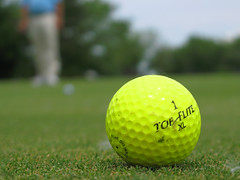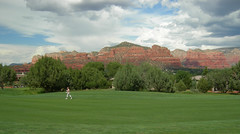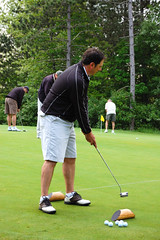Know Your Turf
 Bentgrass is not well-adapted to southern climates. Bentgrass in the South is limited to putting greens, and even then requires a certain temperate climate, extensive management, and high-input costs. Typically, the high maintenance costs of Bentgrass greens in the South are not cost-effective. However, New England states and the Pacific Northwest have ideal climatic conditions for Bentgrass. In Europe and parts of Asia, the grass is native and commonly found in most turf.
Fescue is often considered a low-input cool season grass. Fescue is commonly found on golf courses that are in coastal regions of the U.S. and Great Britain. Fescue is primarily found in the rough. It is a very sturdy grass that turns golden and can grow three feet high. Fescue is sometimes used as a fairway grass, especially in native coastal regions.
Kentucky bluegrass and perennial ryegrass are often found on northern cooler climate golf courses. Some characteristics are an upright growth habit, tolerance to close mowing, and the aesthetic appeal of “striping” that reel mowers create on the turf. Both types of grasses do not tolerate high heat and can be susceptible to diseases when stressed.
Mention the words Poa annua to a greens superintendent in the South and you will hear many unkind words spoken about this grass. It is considered a major weed on golf course putting greens and fairways in many parts of the United States and the world.
The truth is, in northern and cooler climates, Poa annua greens are considered the norm and can provide good putting surfaces. It is often mixed with Bentgrass and some rye grasses. There are many different sub-species of Poa annua, and some greens are infested with as many as twenty different types.
The secret to Poa annua greens lies in utilizing only the varieties that provide high quality putting surfaces. As seen at Oakmont and Torrey Pines, Poa annua mixed with Bentgrass can provide a championship-caliber putting surface.
Many northern golf courses also have a close cousin of Poa annua call Poa trivialis. It is sometimes considered a weed, but it can provide a high quality putting surface, as well. In fact, it is often used to winter overseed Bermudagrass greens in the South.
Southern Climates
Southern climates are better suited for warm season grasses that can withstand the harsher climates. The South offers a variety of climate problems, such as warm summers and cold winters, heat, drought, excessive rain, and high humidity. The most common grass is Bermuda, with its many varieties, but there is some progress being made with other grasses such as zoysia and Seashore Paspalum. In the extreme South, putting greens are almost exclusively Bermuda.
Bermuda grass is a major turf species for golf courses. In the United States, the distribution of Bermuda grass extends from New Jersey and Maryland southward to Florida, and westward to Kansas and Texas. Modern irrigation extends Bermuda grass use westward to southern New Mexico, Arizona and California. Recently, the development of more cold-hardy varieties of Bermuda grass has increased use near its northern limits.
Bentgrass is not well-adapted to southern climates. Bentgrass in the South is limited to putting greens, and even then requires a certain temperate climate, extensive management, and high-input costs. Typically, the high maintenance costs of Bentgrass greens in the South are not cost-effective. However, New England states and the Pacific Northwest have ideal climatic conditions for Bentgrass. In Europe and parts of Asia, the grass is native and commonly found in most turf.
Fescue is often considered a low-input cool season grass. Fescue is commonly found on golf courses that are in coastal regions of the U.S. and Great Britain. Fescue is primarily found in the rough. It is a very sturdy grass that turns golden and can grow three feet high. Fescue is sometimes used as a fairway grass, especially in native coastal regions.
Kentucky bluegrass and perennial ryegrass are often found on northern cooler climate golf courses. Some characteristics are an upright growth habit, tolerance to close mowing, and the aesthetic appeal of “striping” that reel mowers create on the turf. Both types of grasses do not tolerate high heat and can be susceptible to diseases when stressed.
Mention the words Poa annua to a greens superintendent in the South and you will hear many unkind words spoken about this grass. It is considered a major weed on golf course putting greens and fairways in many parts of the United States and the world.
The truth is, in northern and cooler climates, Poa annua greens are considered the norm and can provide good putting surfaces. It is often mixed with Bentgrass and some rye grasses. There are many different sub-species of Poa annua, and some greens are infested with as many as twenty different types.
The secret to Poa annua greens lies in utilizing only the varieties that provide high quality putting surfaces. As seen at Oakmont and Torrey Pines, Poa annua mixed with Bentgrass can provide a championship-caliber putting surface.
Many northern golf courses also have a close cousin of Poa annua call Poa trivialis. It is sometimes considered a weed, but it can provide a high quality putting surface, as well. In fact, it is often used to winter overseed Bermudagrass greens in the South.
Southern Climates
Southern climates are better suited for warm season grasses that can withstand the harsher climates. The South offers a variety of climate problems, such as warm summers and cold winters, heat, drought, excessive rain, and high humidity. The most common grass is Bermuda, with its many varieties, but there is some progress being made with other grasses such as zoysia and Seashore Paspalum. In the extreme South, putting greens are almost exclusively Bermuda.
Bermuda grass is a major turf species for golf courses. In the United States, the distribution of Bermuda grass extends from New Jersey and Maryland southward to Florida, and westward to Kansas and Texas. Modern irrigation extends Bermuda grass use westward to southern New Mexico, Arizona and California. Recently, the development of more cold-hardy varieties of Bermuda grass has increased use near its northern limits.
 Bermuda grass is a warm-season perennial species adapted to tropical and subtropical climates. It grows best under extended periods of high temperatures, mild winters, and moderate-to-high rainfall. It does not tolerate low winter temperature and becomes dormant when average temperatures drop below 50°F, and the grass begins to discolor. Temperatures below freezing kill the leaves and stems. Bermuda grass remains dormant until average daily temperatures rise above 50°F for several days. In warm climates that are frost-free, Bermuda grass remains green throughout the year.
With the right climate, Bermuda grass is known for its hardiness on golf courses. There are many new modern varieties that specialize in certain usages such as fairway grass, tee boxes, and putting greens. In the past, Bermuda grass greens were known for a “graininess” that was not desirable. But, with recent development in finer hybrids, Bermuda greens are beginning to rival Bentgrass’s dominance as king of putting surfaces. Some of these new putting green hybrids are Mini Verde, Champion, and TifEagle. One unique aspect of hybridized Bermuda is that it must be plugged, sprigged, or sodded, as hybrid Bermuda grasses are sterile.
In temperate climates where Bermuda becomes dormant in the winter, there has been development of hybridized Bermuda that tolerates more cold. However, often facilities in temperate climates simply “overseed” the golf course in winter with cool season grasses such as rye and Poa trivialis.
Bermuda grass tends to build up a thatch layer of un-decomposed organic matter just above the soil surface. This is often seen in putting greens. Proper mowing is essential to prevent the accumulation of thatch in turf. Also, thatch removal by mechanical means is required. Vertical mowers (verti-cutting) are used to remove excess thatch and grain, especially on putting surfaces.
In recent years zoysia grass and Seaside Paspalum have shown some promise as a golf course turf grasses, especially on fairways and tee boxes. Zoysia grasses are among the most wear-tolerant turf grasses. However, it has a slow rate of growth and takes longer to recuperate. It can tolerate some shade and is often used on tee boxes where Bermuda grass will not perform. Like Bermuda grass, zoysia grass tends to build up a thatch layer and requires some verti-cutting.
Bermuda grass is a warm-season perennial species adapted to tropical and subtropical climates. It grows best under extended periods of high temperatures, mild winters, and moderate-to-high rainfall. It does not tolerate low winter temperature and becomes dormant when average temperatures drop below 50°F, and the grass begins to discolor. Temperatures below freezing kill the leaves and stems. Bermuda grass remains dormant until average daily temperatures rise above 50°F for several days. In warm climates that are frost-free, Bermuda grass remains green throughout the year.
With the right climate, Bermuda grass is known for its hardiness on golf courses. There are many new modern varieties that specialize in certain usages such as fairway grass, tee boxes, and putting greens. In the past, Bermuda grass greens were known for a “graininess” that was not desirable. But, with recent development in finer hybrids, Bermuda greens are beginning to rival Bentgrass’s dominance as king of putting surfaces. Some of these new putting green hybrids are Mini Verde, Champion, and TifEagle. One unique aspect of hybridized Bermuda is that it must be plugged, sprigged, or sodded, as hybrid Bermuda grasses are sterile.
In temperate climates where Bermuda becomes dormant in the winter, there has been development of hybridized Bermuda that tolerates more cold. However, often facilities in temperate climates simply “overseed” the golf course in winter with cool season grasses such as rye and Poa trivialis.
Bermuda grass tends to build up a thatch layer of un-decomposed organic matter just above the soil surface. This is often seen in putting greens. Proper mowing is essential to prevent the accumulation of thatch in turf. Also, thatch removal by mechanical means is required. Vertical mowers (verti-cutting) are used to remove excess thatch and grain, especially on putting surfaces.
In recent years zoysia grass and Seaside Paspalum have shown some promise as a golf course turf grasses, especially on fairways and tee boxes. Zoysia grasses are among the most wear-tolerant turf grasses. However, it has a slow rate of growth and takes longer to recuperate. It can tolerate some shade and is often used on tee boxes where Bermuda grass will not perform. Like Bermuda grass, zoysia grass tends to build up a thatch layer and requires some verti-cutting.
 Seashore Paspalum is the newest golf and sports turf grass. It has many favorable attributes, including hardiness for some harsh conditions. It can be used in conditions that are not an ideal environment for other grasses, such as Bermuda. When lack of fresh water is an issue, Paspalums can tolerate water that is effluent, brackish or with a certain amounts of salinity. This quality makes it ideal for harsh environment regions, including areas affected by salt water spray, tropical storms, and various other challenging conditions.
Typically, Paspalum is used in fairway and rough areas, although a new variety called “SeaDwarf” is now being used on putting greens. Paspalum is offering some exciting new options for golf courses to go more “green” with less maintenance costs.
Maintenance Practices
After understanding which grasses best fit each facility, maintenance practices become a major issue in keeping the golf course up to certain standards. These standards are dictated by available budget, clientele, and goals of each facility.
The turf must be able to tolerate low heights of cut, weather conditions, and wear-and-tear. The secret to keeping golf course turf up to standard is to keep it strong and healthy. Important things that affect turf health are sunlight, air movement, irrigation and drainage.
The turf grasses are cut at low heights; therefore, they require plenty of sunlight, especially in the morning. This is important to remember when considering the placement of current trees and future tree plantings.
Air movement is also important, especially during hot and/or humid days. Again, too many trees are often the culprit for poor air circulation. Locations in valleys or bottoms of slopes also decrease air flow.
Water is a major factor in golf course turf. Remember, it is as important to be able to put water on the turf quickly, but it is equally important to remove water quickly with proper drainage. A good golf course management program should have an irrigation system that will give even coverage, especially on the greens. Excessive water from rain needs to be removed through drainage. This is achieved by good surface and subsurface drainage.
Each facility should have a golf course management program with an agronomic plan. Fertilizer should be based on soil test results. Fertilizer and chemical applications are a big expense for a golf course. The trend is to go with more natural methods to be more economical and environmentally friendly. Aerating, verti-cutting, and topdressing are other important practices which control the natural organic layer of thatch that will develop. The turf must be cut often; therefore, adequate equipment and manpower are large parts of the budget plan.
Conclusions
Today’s golf course managers need to have certain knowledge of golf course turf and maintenance practices. By understanding the golf facility’s maintenance requirements, it will help the manger:
• communicate with their clients about current facility conditions and projects;
• understand the role of the greens superintendent & challenges of golf course maintenance
• develop maintenance budgets and future projects that will enhance a facility.
Therefore, know your turf!
Seashore Paspalum is the newest golf and sports turf grass. It has many favorable attributes, including hardiness for some harsh conditions. It can be used in conditions that are not an ideal environment for other grasses, such as Bermuda. When lack of fresh water is an issue, Paspalums can tolerate water that is effluent, brackish or with a certain amounts of salinity. This quality makes it ideal for harsh environment regions, including areas affected by salt water spray, tropical storms, and various other challenging conditions.
Typically, Paspalum is used in fairway and rough areas, although a new variety called “SeaDwarf” is now being used on putting greens. Paspalum is offering some exciting new options for golf courses to go more “green” with less maintenance costs.
Maintenance Practices
After understanding which grasses best fit each facility, maintenance practices become a major issue in keeping the golf course up to certain standards. These standards are dictated by available budget, clientele, and goals of each facility.
The turf must be able to tolerate low heights of cut, weather conditions, and wear-and-tear. The secret to keeping golf course turf up to standard is to keep it strong and healthy. Important things that affect turf health are sunlight, air movement, irrigation and drainage.
The turf grasses are cut at low heights; therefore, they require plenty of sunlight, especially in the morning. This is important to remember when considering the placement of current trees and future tree plantings.
Air movement is also important, especially during hot and/or humid days. Again, too many trees are often the culprit for poor air circulation. Locations in valleys or bottoms of slopes also decrease air flow.
Water is a major factor in golf course turf. Remember, it is as important to be able to put water on the turf quickly, but it is equally important to remove water quickly with proper drainage. A good golf course management program should have an irrigation system that will give even coverage, especially on the greens. Excessive water from rain needs to be removed through drainage. This is achieved by good surface and subsurface drainage.
Each facility should have a golf course management program with an agronomic plan. Fertilizer should be based on soil test results. Fertilizer and chemical applications are a big expense for a golf course. The trend is to go with more natural methods to be more economical and environmentally friendly. Aerating, verti-cutting, and topdressing are other important practices which control the natural organic layer of thatch that will develop. The turf must be cut often; therefore, adequate equipment and manpower are large parts of the budget plan.
Conclusions
Today’s golf course managers need to have certain knowledge of golf course turf and maintenance practices. By understanding the golf facility’s maintenance requirements, it will help the manger:
• communicate with their clients about current facility conditions and projects;
• understand the role of the greens superintendent & challenges of golf course maintenance
• develop maintenance budgets and future projects that will enhance a facility.
Therefore, know your turf!










